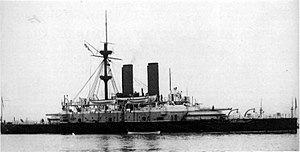Our website is made possible by displaying online advertisements to our visitors.
Please consider supporting us by disabling your ad blocker.
HMS Collingwood (1882)
 Collingwood at anchor
| |
| History | |
|---|---|
| Name | Collingwood |
| Namesake | Admiral Cuthbert Collingwood |
| Builder | Pembroke Dockyard |
| Laid down | 12 July 1880 |
| Launched | 22 November 1882 |
| Completed | July 1887 |
| Fate | Sold for scrap, 11 May 1909 |
| General characteristics | |
| Class and type | Admiral-class ironclad battleship |
| Displacement | 9,500 long tons (9,700 t) |
| Length | 325 ft (99.1 m) (p.p.) |
| Beam | 68 ft (20.7 m) |
| Draught | 26 ft 11 in (8.2 m) |
| Installed power | 7,000 ihp (5,200 kW) (normal) |
| Propulsion |
|
| Speed | 16.8 kn (31.1 km/h; 19.3 mph) (forced draught) |
| Range | 8,500 nmi (15,700 km; 9,800 mi) at 10 knots (19 km/h; 12 mph) |
| Complement | 498 |
| Armament |
|
| Armour |
|
HMS Collingwood was the lead ship of her class of ironclad battleships built for the Royal Navy during the 1880s. The ship's essential design became the standard for most of the following British battleships. Completed in 1887, she spent the next two years in reserve before she was assigned to the Mediterranean Fleet for the next eight years. After returning home in 1897, the ship spent the next six years as a guardship in Ireland. Collingwood was not significantly damaged during an accidental collision in 1899 and was paid off four years later. The ship was sold for scrap in 1909 and subsequently broken up.
Previous Page Next Page


